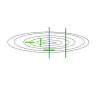My questions is about the difference between antenna radiating strength and polarity.
See my attached graphic.
Blue Antenna = TX
Green Antennas = RX
Let's call the RX antennas 1 to 4, from left to right.
All RX are in the same plane as the radiating field of the TX so they are all sitting in the strongest part of the field.
RX1 won't have any reception. Although RX1 is sitting in the strongest part of the TX field, the TX is sitting in the weakest part of the RX1's field (the blind spot at the tips).
RX2 and RX3 also won't have any reception? Because it is not perpindicular to the radiating disc? Would it not be like trying to induce current flow in a wire by moving a magnet along it rather than across it?
RX4 will receive optimally because antennas transmit the same way they receive and RX 4 is oriented in the field the same way the TX is.
I am fairly sure about RX1 and RX4 (basically both antennas have to mutually be in the strongest part of each other's field for optimal reception). But I am not sure about RX2 and RX3 since they are sitting in the strongest part of each other's field, but they are oriented differently wrt to each other's radiating discs. I ran by some graphics from the Spektrum RC website that, if taken at face value would impy that RX2 and RX3 would work.
**broken link removed**
EDIT: I also found this neat graphic:
File ipolentstehung.gif - Wikipedia, the free encyclopedia
ipolentstehung.gif - Wikipedia, the free encyclopedia
So from the blue lines in the capacitive plates and the red lines being perpindicular to AC current flow, I suppose it would be correct to say that the blue lines represent the electric field and the red lines represent the magnetic field. So reworded, my question would be...for an antenna (a dipole one anyways) to optimally receive it MUST be perpindicular to the radiated magnetic field (or parallel to the electric field). Makes complete sense now that I say it aloud and have a graphic to look at.
See my attached graphic.
Blue Antenna = TX
Green Antennas = RX
Let's call the RX antennas 1 to 4, from left to right.
All RX are in the same plane as the radiating field of the TX so they are all sitting in the strongest part of the field.
RX1 won't have any reception. Although RX1 is sitting in the strongest part of the TX field, the TX is sitting in the weakest part of the RX1's field (the blind spot at the tips).
RX2 and RX3 also won't have any reception? Because it is not perpindicular to the radiating disc? Would it not be like trying to induce current flow in a wire by moving a magnet along it rather than across it?
RX4 will receive optimally because antennas transmit the same way they receive and RX 4 is oriented in the field the same way the TX is.
I am fairly sure about RX1 and RX4 (basically both antennas have to mutually be in the strongest part of each other's field for optimal reception). But I am not sure about RX2 and RX3 since they are sitting in the strongest part of each other's field, but they are oriented differently wrt to each other's radiating discs. I ran by some graphics from the Spektrum RC website that, if taken at face value would impy that RX2 and RX3 would work.
**broken link removed**
EDIT: I also found this neat graphic:
File
So from the blue lines in the capacitive plates and the red lines being perpindicular to AC current flow, I suppose it would be correct to say that the blue lines represent the electric field and the red lines represent the magnetic field. So reworded, my question would be...for an antenna (a dipole one anyways) to optimally receive it MUST be perpindicular to the radiated magnetic field (or parallel to the electric field). Makes complete sense now that I say it aloud and have a graphic to look at.
Attachments
Last edited:


